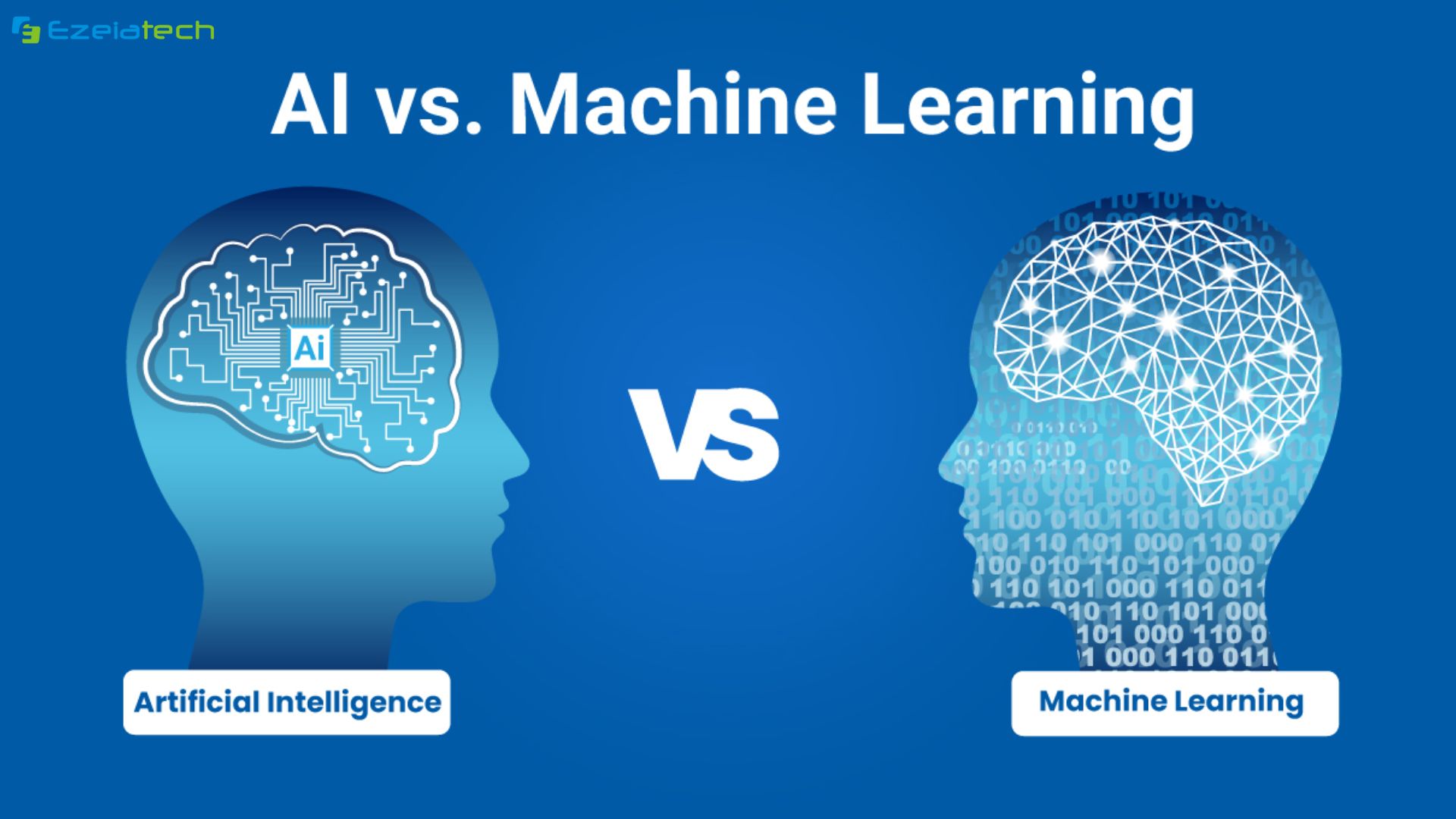Did you know that 90% of the world’s data has been generated in the last two years alone? With this explosive growth in data, the demand for advanced technology solutions has also skyrocketed. Two transformative technologies that have emerged are Machine Learning vs AI. While these terms are often used interchangeably, there are distinct differences between them.
In this article, we will delve into the key differences between machine learning and AI. We will explore how these technologies differ from each other and the various ways in which they intersect. By understanding the nuances of machine learning and AI, we can harness their potential to drive innovation and transform industries.
Understanding Machine Learning
In this section, we will provide an in-depth understanding of machine learning. We will explain the concepts, algorithms, and techniques involved in machine learning and how it is different from AI.
Machine learning is a subset of artificial intelligence that focuses on enabling computers to learn and make predictions or decisions without explicit programming. It involves the use of algorithms and statistical models to analyze and interpret large data sets, allowing computers to find patterns, make predictions, and improve performance over time.
One of the key differences between machine learning and AI is that machine learning is data-driven, relying on the availability of high-quality and relevant data for training and learning. AI, on the other hand, is a broader concept that aims to replicate human intelligence and encompasses various technologies and approaches, including machine learning.
Machine learning algorithms can be categorized into three main types: supervised learning, unsupervised learning, and reinforcement learning. In supervised learning, the algorithm is trained on labeled data, with inputs and corresponding outputs provided. Unsupervised learning involves training on unlabeled data, allowing the algorithm to find patterns and relationships without prior knowledge of the correct outputs. Reinforcement learning focuses on training an algorithm through interaction with an environment, where it receives feedback and learns from its actions.
Common machine learning techniques include linear regression, support vector machines, decision trees, random forests, and neural networks. These techniques enable machines to analyze complex data, identify patterns, and make accurate predictions or decisions based on the learned knowledge.
“Machine learning is the foundation of many AI applications. By employing advanced algorithms and statistical models, machine learning enables computers to learn, adapt, and improve over time.”
To better understand the differences between machine learning and AI, it’s important to acknowledge that while machine learning is a crucial component of AI, AI encompasses broader aspects of intelligent systems, including natural language processing, computer vision, robotics, and expert systems.
In the next section, we will dive into artificial intelligence, exploring its definition, applications, and capabilities, and highlighting the key distinctions between AI and machine learning.
Discovering Artificial Intelligence
In this section, we will delve into the fascinating world of artificial intelligence (AI). We will explore its definition, applications, and capabilities, shedding light on the intricacies of this transformative technology.
Artificial intelligence is the branch of computer science that focuses on creating intelligent machines capable of performing tasks that typically require human intelligence. Unlike machine learning, which is a subset of AI, AI encompasses a broader range of techniques and approaches.
AI has found applications in various fields, including healthcare, finance, transportation, and beyond. From autonomous vehicles to virtual assistants, AI has the potential to revolutionize our lives and reshape industries.
One key distinction between AI and machine learning is that AI aims to create machines that can simulate human intelligence and reasoning, while machine learning focuses on enabling machines to learn from data and improve their performance over time.
By understanding the capabilities and limitations of AI, we can unlock its immense potential and harness its power to solve complex problems, enhance decision-making processes, and drive innovation.
Artificial intelligence is the science of making machines do things that would require intelligence if done by humans.
– Marvin Minsky, American computer scientist
The Intersection of Machine Learning and AI
In this section, we will delve into the fascinating intersection of machine learning and AI. These two transformative technologies, although distinct, collaborate closely to create intelligent systems that have revolutionized various industries. Understanding the similarities and distinctions between machine learning and AI is crucial in harnessing their combined power to drive innovation and solve complex problems.
Similarities and Distinctions:
Machine learning and AI are often used interchangeably, but they have some important similarities and distinctions. Both involve the development of computer systems capable of performing tasks that would typically require human intelligence. However, machine learning is a subset of AI that focuses on algorithms and statistical models to enable computers to learn from data and make accurate predictions or decisions without being explicitly programmed.
On the other hand, AI encompasses a broader set of technologies that aim to replicate human-like intelligence across a wide range of applications. While machine learning relies on data-driven approaches, AI can incorporate various techniques such as natural language processing, computer vision, and expert systems to simulate human intelligence. AI systems can understand, reason, and learn from data, enabling them to perform complex tasks and adapt to new situations.
Collaboration for Intelligent Systems:
Machine learning and AI work collaboratively to create intelligent systems and drive advancements in various domains. The data-driven nature of machine learning provides the foundation for AI systems to process and analyze vast amounts of data, identifying patterns and making informed decisions.
For example, machine learning algorithms can be used to train AI models for image recognition, natural language understanding, and predictive analytics. By continuously learning from new data, these models can improve their accuracy and performance over time, making them essential in applications such as self-driving cars, virtual assistants, and personalized recommendations.
The Future of Machine Learning and AI:
The intersection of machine learning and AI holds immense potential for driving innovation and transforming industries. As data continues to grow exponentially, machine learning techniques will play a crucial role in extracting valuable insights and making sense of complex information. AI, fueled by machine learning, will continue to revolutionize various areas, such as healthcare, finance, robotics, and cybersecurity.
The collaboration between machine learning and AI also raises important ethical considerations. As these technologies become more sophisticated, ensuring transparency, fairness, and accountability in their decision-making processes becomes paramount. Striking the right balance between innovation and responsible use of machine learning and AI will be crucial in realizing their full potential while mitigating risks.
| Machine Learning | AI |
|---|---|
| Focuses on algorithms and statistical models to enable computers to learn from data and make accurate predictions or decisions. | Encompasses a broader set of technologies that aim to replicate human-like intelligence across various applications. |
| Relies on data-driven approaches to train models and improve performance over time. | Incorporates techniques such as natural language processing, computer vision, and expert systems to simulate human intelligence. |
| Used in applications such as personalized recommendations, image recognition, and predictive analytics. | Applied in areas like virtual assistants, self-driving cars, and data analysis. |
Use Cases for Machine Learning
In this section, we will explore the various use cases of machine learning, showcasing its practical applications in different industries. Machine learning, a subset of artificial intelligence, utilizes algorithms and statistical models to enable computer systems to learn from data and make predictions or decisions without explicit programming.
Machine learning enables automation, optimization, and efficiency in a wide range of fields, revolutionizing industries and shaping the future of technology.
Let’s dive into some notable use cases where machine learning has made a significant impact:
- Healthcare Diagnosis and Prediction
- Financial Services and Fraud Detection
- E-commerce and Recommendation Systems
- Autonomous Vehicles
- Natural Language Processing
These examples illustrate just a fraction of the potential applications of machine learning. As technology continues to advance, machine learning will undoubtedly play an increasingly critical role in shaping the future of various industries.
Use Cases for Artificial Intelligence
In this section, we will explore the practical applications of artificial intelligence (AI) across various domains. With its ability to analyze large volumes of data and make intelligent decisions, AI is revolutionizing industries and solving complex problems.
AI-Powered Virtual Assistants
One compelling use case for AI is the development of virtual assistants like Siri, Alexa, and Google Assistant. These intelligent virtual entities use natural language processing and machine learning algorithms to understand and respond to user queries. From scheduling appointments to answering questions, virtual assistants are streamlining tasks and enhancing user experiences.
Smart Home Automation
AI is transforming homes into smart living spaces with automated systems that improve convenience and energy efficiency. AI-powered devices like smart thermostats, lighting systems, and home security systems can learn from user behavior and adapt accordingly. These systems enable seamless control and personalization, making homes more comfortable and secure.
Healthcare and Diagnostics
AI is making great strides in the field of healthcare, empowering medical professionals and enhancing patient care. Machine learning algorithms can analyze medical images, such as X-rays and MRIs, to detect early signs of diseases and assist with accurate diagnoses. AI also plays a vital role in genomics research, drug discovery, and personalized medicine.
Autonomous Vehicles
The development of autonomous vehicles is one of the most exciting use cases for AI. Self-driving cars rely on AI algorithms to perceive their environment, make decisions, and navigate safely. By integrating sensors, cameras, and advanced AI systems, autonomous vehicles have the potential to revolutionize transportation and reduce accidents on the road.
Predictive Analytics and Fraud Detection
AI enables businesses to leverage predictive analytics for making data-driven decisions and reducing risks. Machine learning algorithms can analyze vast amounts of data to detect patterns, predict trends, and identify potential fraud. From credit card fraud detection to cybersecurity, AI plays a crucial role in safeguarding businesses and individuals.
Customer Service and Chatbots
AI-powered chatbots are transforming customer service by providing instant support and personalized experiences. These virtual agents can handle simple customer queries, offer product recommendations, and assist with troubleshooting. By leveraging AI, businesses can provide round-the-clock customer support and enhance customer satisfaction.
AI is transforming industries and solving complex problems through virtual assistants, smart home automation, healthcare and diagnostics, autonomous vehicles, predictive analytics, and customer service applications.
Challenges and Limitations of Machine Learning and AI
While machine learning and artificial intelligence (AI) offer unprecedented opportunities for innovation and problem-solving, they also come with their fair share of challenges and limitations. Understanding and addressing these issues is crucial for harnessing the full potential of these technologies. In this section, we will explore some of the key challenges faced by both machine learning and AI, including issues related to data quality, bias, interpretability, and ethical considerations.
Data Quality
Machine learning and AI systems heavily rely on data to make predictions and decisions. However, the quality of the data used can significantly impact the accuracy and reliability of the results. Challenges related to data quality include incomplete or inconsistent data, data bias, and data labeling errors, among others. Ensuring the availability of high-quality and representative data sets is essential for building robust and trustworthy machine learning and AI models.
Bias
Bias is a critical challenge in both machine learning and AI. Machine learning algorithms learn patterns and make predictions based on the data they are trained on. If the training data contains biases, such as gender or racial biases, the resulting models can perpetuate and amplify these biases. Addressing bias requires careful data selection, preprocessing, and algorithm design to ensure fairness and avoid discrimination in machine learning and AI applications.
Interpretability
Machine learning and AI algorithms often operate as black boxes, making it challenging to understand the reasons behind their decisions. This lack of interpretability can be a significant limitation, especially in sensitive areas such as healthcare and finance. Ensuring transparency and interpretability in machine learning and AI models is crucial for building trust and enabling human oversight, especially in critical decision-making processes.
Ethical Considerations
The development and deployment of machine learning and AI technologies raise ethical concerns. These include questions about privacy, fairness, accountability, and the potential impact on employment and society as a whole. Ensuring ethical considerations are embedded throughout the lifecycle of machine learning and AI systems is essential for responsible and beneficial deployment.
By understanding and addressing these challenges and limitations, we can foster the responsible and effective use of machine learning and AI, unlocking their potential to revolutionize industries and solve complex problems.
| Challenges | Machine Learning | Artificial Intelligence |
|---|---|---|
| Data Quality | ✓ | ✓ |
| Bias | ✓ | ✓ |
| Interpretability | ✓ | ✓ |
| Ethical Considerations | ✓ | ✓ |
Conclusion
In summary, the comparison of machine learning and artificial intelligence reveals both similarities and distinctions between these transformative technologies. Machine learning, a subset of AI, focuses on enabling systems to learn from data and make predictions or take actions without being explicitly programmed. On the other hand, AI encompasses broader concepts and aims to replicate human intelligence in machines.
While machine learning and AI intersect in many ways, it is essential to differentiate between them. Machine learning algorithms rely on vast amounts of data to train models and improve their performance over time. In contrast, AI systems strive to exhibit intelligence, reasoning, and problem-solving abilities beyond what traditional programming can achieve.
Understanding the differences between machine learning and AI is critical for businesses and individuals looking to leverage their potential. Machine learning excels in areas such as pattern recognition, predictive analytics, and personalized recommendations, making it a valuable tool in industries like finance, healthcare, and e-commerce. AI, on the other hand, holds the promise of revolutionizing sectors with complex decision-making processes, such as autonomous vehicles, natural language processing, and robotics.
As these technologies continue to advance, it is important to consider the challenges and limitations they pose. Concerns around data quality, biases, interpretability, and ethical implications require careful consideration to ensure responsible development and deployment of machine learning and AI systems.
Thank you for reading. For continued insights and in-depth discussions, please follow our blogs at Ezeiatech







